Assessing children's work with ticks and crosses isn't much use to anyone, says Stephen Bowkett. Far better to use symbols...
You may have heard the story of the little girl who, when she went into her new class, met maths for the first time. She came home very pleased and excited and her mother asked, ‘So what did you do at school today Lucy?’ And Lucyexplained that she’d done some sums in her new book, which she proudly showed off to her mother. Lucy’s Mum was upset to see that every answer had been marked wrong, and yet her daughter was still smiling. ‘So did you enjoy doing the sums Lucy?’ ‘Well, not that much,’ Lucy said. ‘But I know that my teacher loves me very much – look how many kisses she put in my book.’
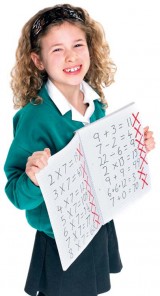 For me there’s both comedy and tragedy here (how will Lucy feel when she discovers what the crosses actually mean?), not least because the classic tick-cross marks are indicative of a negative and corrective mindset when it comes to giving feedback on children’s work. Doubtless education has moved on from the days when, simplistically, the more ticks you got the better you’d done and the more crosses you got the closer you came to extra homework (or in my case having pocket money docked). I do feel though that there may be scope for improving how we can offer feedback on children’s work that is both respectful to them and has learning value.
For me there’s both comedy and tragedy here (how will Lucy feel when she discovers what the crosses actually mean?), not least because the classic tick-cross marks are indicative of a negative and corrective mindset when it comes to giving feedback on children’s work. Doubtless education has moved on from the days when, simplistically, the more ticks you got the better you’d done and the more crosses you got the closer you came to extra homework (or in my case having pocket money docked). I do feel though that there may be scope for improving how we can offer feedback on children’s work that is both respectful to them and has learning value.
Whatever the content of the curriculum, how children make sense of it – i.e. how they think – must remain key. Marking symbols that address children’s work at this level therefore are likely to be very effective in highlighting the ‘thinking skills agenda’ that we can cultivate in the classroom. Here are some examples of what I mean.
This means identifying a topic or focus for thinking and then exploring possible developments, explanations, etc. When I want children to do this I show them the ‘maybe hand’. Ask them to imagine that the point or focus of their thinking lies in the palm of their hand. Each finger stands for a possible reason or explanation – a ‘maybe’. So if you ask ‘Why does a candle flame go out when you put a glass beaker over it?’ five explanations will fit on one hand, ten on two hands etc.
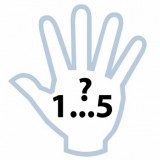 Using the example in point 1, ask the children to discuss how likely or reasonable they think the different explanations are, using a scale of 1-5. One would be judged a highly likely explanation, five a very unlikely one. Once you have introduced the maybe hand and sliding scale you can use the following symbols separately or in conjunction in your marking (see left). You can develop the maybe hand activity by creating a wall display, where the initial question is written in the palm of a large hand and children’s suggested explanations are written or drawn around the fingers (together, if appropriate, with a numerical value for reasonableness).
Using the example in point 1, ask the children to discuss how likely or reasonable they think the different explanations are, using a scale of 1-5. One would be judged a highly likely explanation, five a very unlikely one. Once you have introduced the maybe hand and sliding scale you can use the following symbols separately or in conjunction in your marking (see left). You can develop the maybe hand activity by creating a wall display, where the initial question is written in the palm of a large hand and children’s suggested explanations are written or drawn around the fingers (together, if appropriate, with a numerical value for reasonableness).
This means creating a possible explanation based on some evidence (mixed in perhaps with a few assumptions). It is an important process in science, but can be introduced and practised quickly and easily by playing the Detective Game, as follows.
Show the class a series of clues that could be explained in various ways.
• The kitchen window is open
• There’s an empty plate on the worktop
• There are grease marks on the worktop
• There is a teacloth lying on the floor
• The family cat does not appear when called
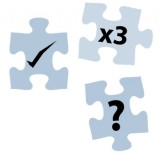
Ask the children what they think could have happened. Although the maybe hand might be used here, the children are going beyond speculation because they can offer evidence to support their ideas. However, you can still bring in the 1-5 scale to explore the likelihood of suggested scenarios.
In terms of thinking / marking symbols you might consider using a simple jigsaw puzzle piece to stand for the idea of a clue. Making small additions to this will indicate (see left) –
• I like the fact that you’ve offered evidence to support your ideas
• What evidence can you think of to back up your ideas?
• I’d like to see three (or whatever) more ideas to support your conclusion / argument
This simple technique is a powerful addition to a child’s thinking toolbox. It can be used when exploring ideas in just about any subject area. The three steps are:
• What do we actually know?
• What do we think we know?
• What can we ask to find out more / to be sure?
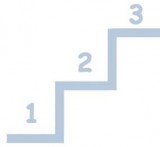 So referring to the detective game above, what we actually know amounts to what we are told. But how many of us assumed that the cat stole food from the plate on the worktop? That the grease marks come from the food? That there was food on the plate in the first place? There’s no actual evidence to suggest these things are true, we’ve simply (and automatically) ‘written them in’ to our narrative. Using the symbol below (see left) not only prompts children to think again about ideas they’ve already written down, but acts as a visual reminder to increase the chances of them thinking more deeply next time.
So referring to the detective game above, what we actually know amounts to what we are told. But how many of us assumed that the cat stole food from the plate on the worktop? That the grease marks come from the food? That there was food on the plate in the first place? There’s no actual evidence to suggest these things are true, we’ve simply (and automatically) ‘written them in’ to our narrative. Using the symbol below (see left) not only prompts children to think again about ideas they’ve already written down, but acts as a visual reminder to increase the chances of them thinking more deeply next time.
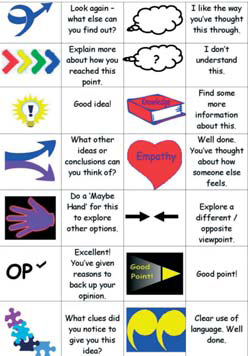 The ideas in this article arise out of specific thinking techniques that hopefully you feel are relevant and want to build into your classroom practice on a regular basis. Thinking / marking symbols can also be devised for a much wider range of purposes and used as quick and simple annotations in children’s notebooks to complement the thinking and creativity underpinning the basic content of what they write. See examples left.
The ideas in this article arise out of specific thinking techniques that hopefully you feel are relevant and want to build into your classroom practice on a regular basis. Thinking / marking symbols can also be devised for a much wider range of purposes and used as quick and simple annotations in children’s notebooks to complement the thinking and creativity underpinning the basic content of what they write. See examples left.
Give each child a colour photocopy of your thinking symbols’ chartto paste into their notebook. And / or enlarge the chart to poster size to use as a wall display.
Even simple symbols take time to draw and it would be onerous to do this routinely in children’s books. A more effective method is to import appropriate pieces of clip art into a table in a Word document. Create the desired number of cells, import your chosen clip art and arrange the cell size so that the document prints out on to sheets of sticky labels. It’s easy then to peel off the labels to stick into the margin of a notebook.
How to be a singing school
Ace-Music
Make every lesson an experiment
Cross Curricular
